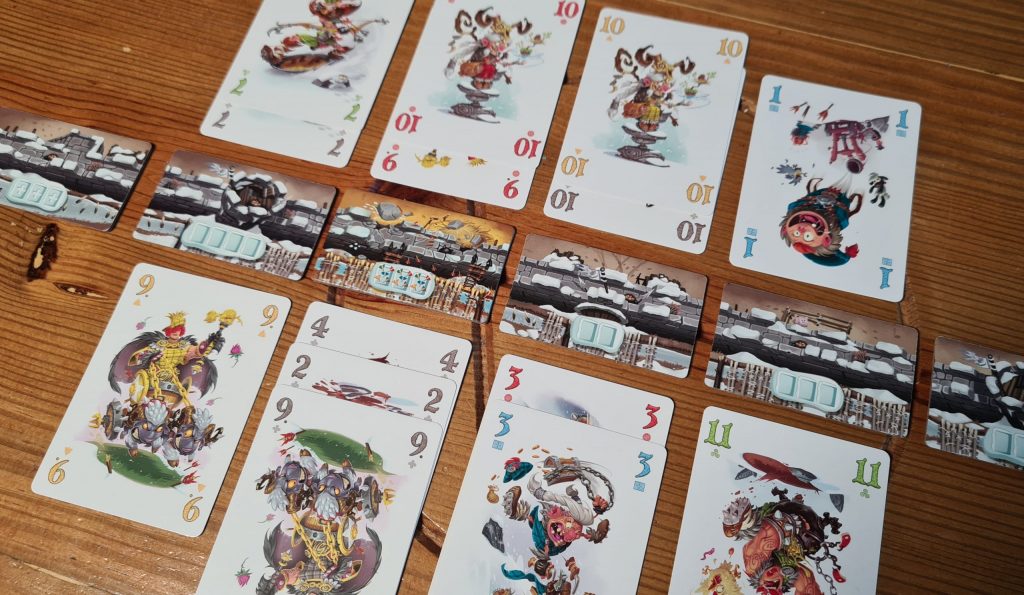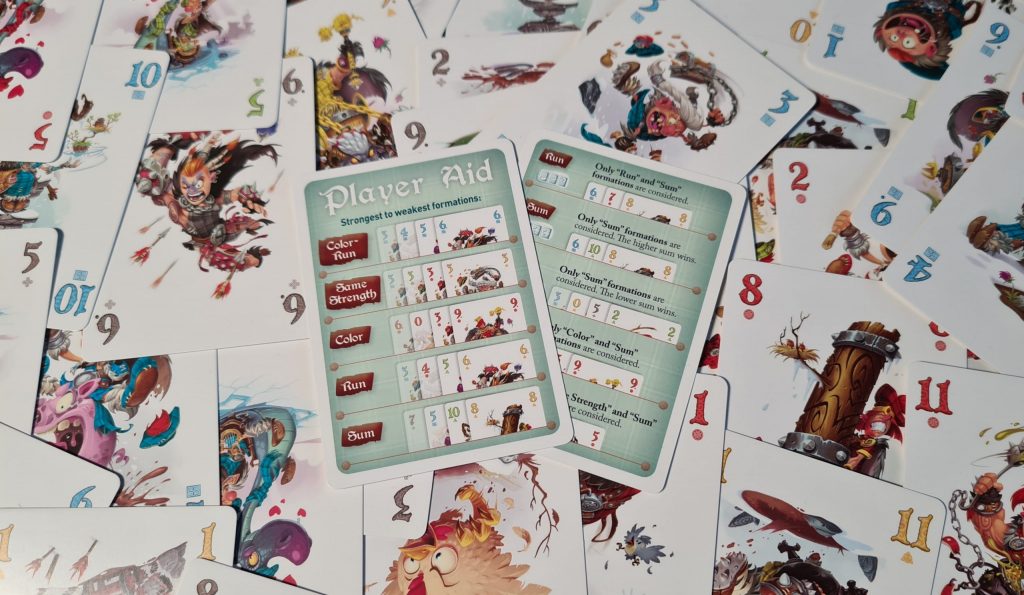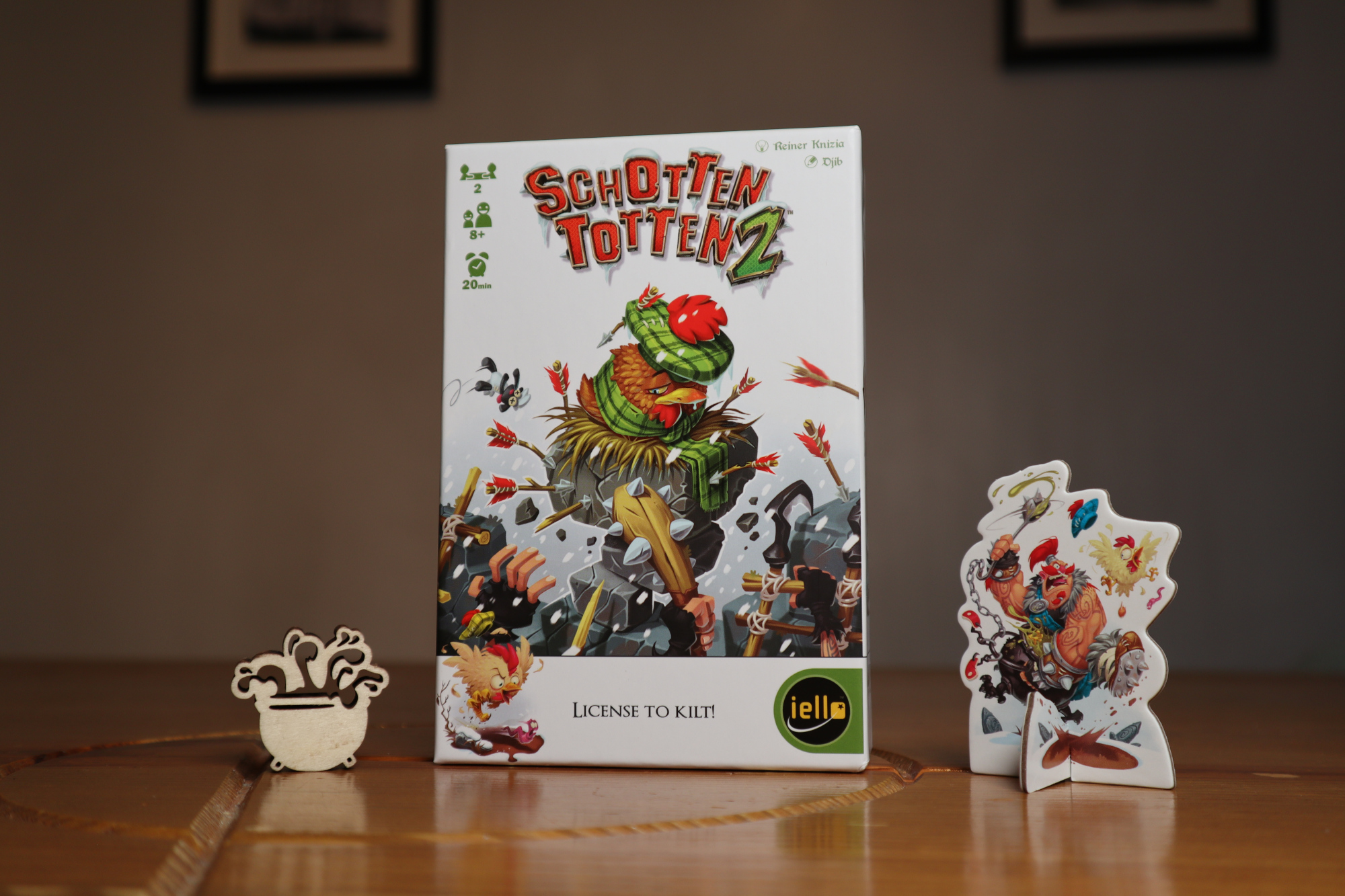Schotten Totten 2 is the brand new hand management and set collection card game, from publisher IELLO. Designed by Dr Reiner Knizia, featuring artwork from Jean-Baptiste Reynaud, the game sees the kilted clans return. Taking around 20 minutes, this two player only game sees one player defending against the other, with asymmetrical abilities and ways to win. However, will you want to keep attacking or defending? Let’s find out!
Schotten Totten 2 sees one player attempting to breach the walls of the other player, by building up unbeatable formations. The wall is made up of seven tiles, which start on their undamaged side, lined up along the middle of the table. Each of these wall tiles will have cards played to them to either the attackers or defenders side, with each holding between 2 – 4 cards – the exact number being denoted on the specific wall tile. The cards that make up the formations come in 5 colour sets and have numbers ranging from 0 to 11.
Starting with 6 cards each the attacking player makes the first move, playing a card from their hand to their side of any of the seven wall tiles. Attempting to build up Poker like formations in front of the wall tiles the attacker is aiming to make an unbeatable formation. Formations can take a number of forms such as a run of numbers, for example 3, 4 and 5, or just matching colour, which is like matching suit. The strongest formation type is a colour run, a run where all the cards are identical colour, with the weakest being a simple sum formation, adding the card values together. Most of the 7 wall tiles can be won with any formation type, while others and damaged wall tiles can only be won with specific formations.
When all formations are allowed then the player with the better formation (i.e. a run beats a sum formation) wins. Until the defender has put all of their cards down though the attacker can only win by proving they cannot be beaten. Looking at a lowest sum wins wall tile, which is denoted as a 3 card tile, as an example the attacker may have two 0s and a 1 played. Unless the remaining zeros are all played elsewhere or discarded the attacked cannot prove that the defender won’t be able to mount a stronger formation as a defence.

For the first few turns play will go back and forth, with the attacker playing a card and drawing a card from the deck to replace it, followed by the defender doing the same. Before long the wall tiles will start to build up with cards and what your opponent is trying to do will become clearer, with what formations they are building up where becoming apparent. Both players have a trick up their sleeve. The attacker can retreat at the start of their turn. This may sound unhelpful but the defender cannot retreat. Therefore, whenever a defender plays a card somewhere it is locked in for good. If the defender builds a formation of three 4s to beat the attackers three 2s the attacker can simply remove them and start building a better formation. The defender however can spend one of their three oil cauldron tokens to discard the closest attacker card on any of the wall tiles.
At the end of each of their turns if the attacker can prove any of their formations is unbeatable they damage the wall section. This sees the wall tile flipped over to the damaged side, which has a new formation requirement, and all cards from both sides of that wall tile discarded. The aim of the game of the attacker is to either wear down the defences of the defender enough, by damaging the wall in four places, or to penetrate the wall, by damaging an already damaged wall section. The defender merely needs to stop this from happening, before the deck runs out, though the attacker always gets the final turn of the game to have a last ditch attempt.
Many games aim to go down to the wire but Schotten Totten 2 is one of those games that actively manages it game after game. Causing this consistency is the way that the attacker must be able to prove that the defender cannot beat them. At the offset of the game a player can play a phenomenal formation to a wall section and be unable to yet prove they are unstoppable. For example, playing two 11s and one 10 to the sum formation tile can still be beaten by three 11s. Until part way through the game when another 11 is played it cannot be proved, giving the defender ample time to use one of their cauldrons. Towards the end of the game more and more information becomes available, allowing the attacker to prove more and tweak attacks accordingly.
There is the possibility for Schotten Totten 2 to have a very low entry point into the hobby or come with a bit of a learning curve. For those whom have played Poker before then the formations from runs to same strength are like straights and flushes. Therefore, the step to colour runs isn’t exactly a huge leap, which makes the game extremely quick to pick up and instantly players can compete. Coming into the game without that prior knowledge could see players struggle to see how the game will play out in that initial play. Getting past those awkward first few turns and players will be able to start to see how the sets of cards in front of the wall pieces build up and things then start to click. Pitting a player with experience against someone without therefore sees an unbalanced matchup. Though within a game or two that balance can be obtained. It would feel like an uphill battle for the player with less experience and this could put them off the game if not coached through it a bit.

Despite the game going down to the wire there are little moments to remember sprinkled throughout the experience. There is a rule which comes into play when a 0 or an 11 is played, as a 0 and an 11 of the same colour will cancel each other out. These moments feel like you’ve pulled off a little victory over your opponent, though it’s part of an interesting choice as you know that 0 or 11 can’t be cancelled if played elsewhere. It’s never the case that all of the action is on one turn. As the attacker you will be going after different sections of the wall or at least the same section twice. So, there will be that initial mini win of damaging a wall tile before being able to win. As for the defender, stopping a formation in its tracks with an oil cauldron can also be rather satisfying!
For a small box game Schotten Totten 2 still has a fair bit of table presence and a bit of flair that makes it stand out. The deck of cards is of good card stock and each number in the deck has its own unique and entertaining artwork, with the colours of tartan tweaked based on the colour of the suit. The wall tiles down the middle of the table give the game some size, making it look more impressive on the table – though this does mean the game requires at least a medium sized flat surface to play on. The cauldrons that the defender gets to use could easily be small cardboard chits. Instead, the cauldrons are laser cut chunky wooden components that add that bit of flair to the experience. They also offer the defender something to play with in their hands while waiting for the attacker to play their next card!
Once past the barrier of entry (learning the way the formations work) the enjoyment in Schotten Totten 2 starts to flow. There is certainly a disparity between new and experienced players that has caused a spot of negative reaction to the game. However, when on the same level it is incredible how close it can be to pulling off a defence or just breaking through the wall on the final turn of the game. For those moments, Schotten Totten 2 provides an enjoyable twist on typical Poker logic, with the addition of asymmetrical choices that make the two roles feel unique. It might not be for everyone but for those that it clicks with there is plenty of entertainment to be had.
(Editor’s Note: Schotten Totten 2 was provided to us by Coiledspring Games for the review. The game is currently available from local board game stores! Find your local store here.)

